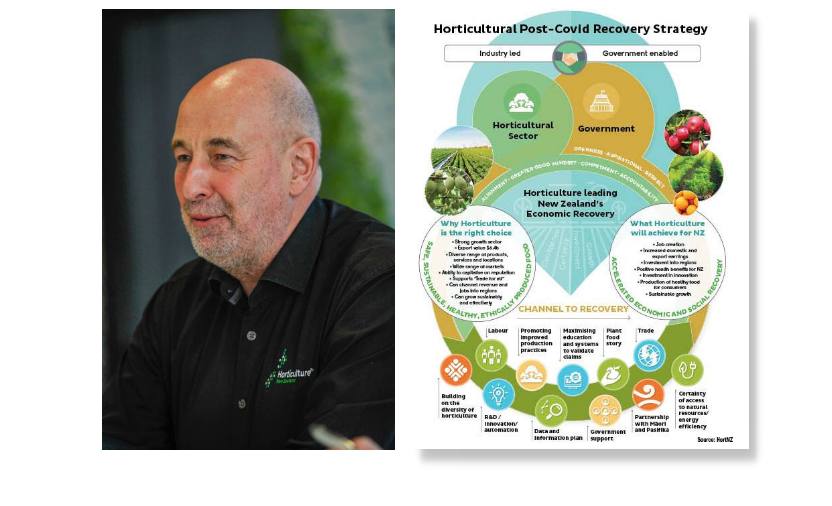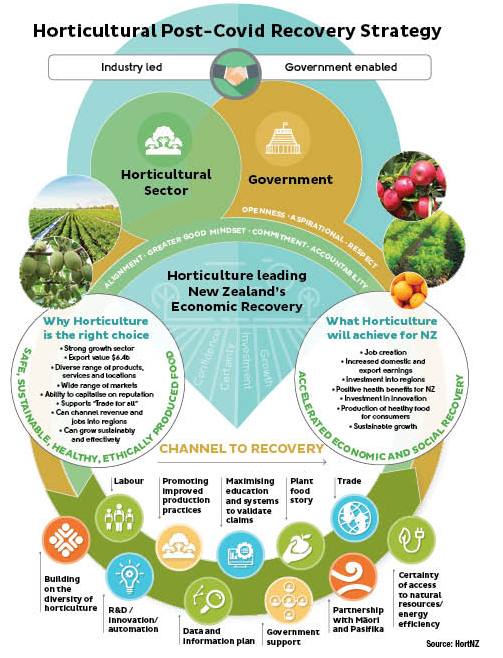The horticulture sector is in a unique position to accelerate the economic potential of the primary sector and aid a post-Covid19 recovery, says Mike Chapman, chief executive of Horticulture New Zealand (HortNZ).

HortNZ, which represents most of the sector, recently released the Horticulture post Covid recovery strategy report on how it hopes to work with government to unleash the sector’s potential.
The sector has a track record of growth that is expected to continue domestically and globally. The 2019 Fresh Facts reported that the value of horticulture then was $6.39 billion ($4.23 billion in export and $2.16 billion in domestic trade).
Pre Covid-19 it was forecast to grow to $10 billion by 2030. At this point, growth for all sectors is obviously uncertain, but the agricultural and farming sectors have been doing better than most and it seems likely demand will remain strong in export markets for food.
But the report notes that domestic and export figures are only part of the real value equation for the horticultural sector. “When you add in the multiplier effect of associated or service industries in New Zealand and globally, IP royalties and the like the true value becomes much clearer,” the report says.
“The sector offers a diverse range of products, services, locations and end markets, and channels revenue and job opportunities into the regions where some of our largest social and economic challenges exist. Most importantly it has a justifiable reputation for safe, sustainable, healthy and ethically produced food.”
Strong sectoral growth
The horticulture sector has been growing more strongly than any other primary sector in recent years and latest export growth figures are proving its resilience through the crisis, according to the report. Yet its true value is generally under recognised and under reported, as the significant global IP and the indirect benefits multiplier, are often not accounted for.
“The industry’s potential for growth in the most sustainable, environmentally friendly, and ethical manner, makes it an ideal sector to lead the recovery with domestic growth and export earnings.”
For example, research conducted by the New Zealand apple industry estimated that the true broader economic benefit of the industry at that time was three to five times its export value. If that is extrapolated, with horticulture exports (including wine) exceeding $6.2 billion in 2019, the economic benefit is huge – and it is primarily focused in the regions.
“The industry’s potential for growth in the most sustainable, environmentally friendly, and ethical manner, makes it an ideal sector to lead the recovery with domestic growth and export earnings. Such growth has many benefits to New Zealand, from clean, green job growth to investment in regional areas and in a range of industries and communities,” the report says.
“It also reflects emerging consumer trends for healthy produce grown in a way and by businesses, that reflect not only the values of today’s consumers, but position New Zealand well to meet the needs of consumers in the post-Covid-19 world. Diversity of crops and produce in various locations provides strength, spreads risk and offers a brand and approach that adds even more value to New Zealand.”
In addition to the sector’s growth and economic potential, it has a vital role feeding first New Zealand and then export consumers and potentially has significant health benefits.
“Recognition of this contribution to the country’s health and well-being as we recover from Covid-19, strongly reinforces the value proposition for additional growth acceleration programmes for the sector,” the report says.
Meeting the need for job creation
Post-Covid-19 New Zealand will be characterised by high unemployment but with a significant skills shortage, says the report. It suggests growth in permanent sustainable jobs will come from:
- Confidence of the industry to continue to invest and grow.
- Increased domestic and overseas market demand for safe, ethical, fresh, healthy produce.
- Training and capability investment to deliver the skills that the industry needs for the future.
- HortNZ says that production growth translates to jobs. For example, apple industry research conducted in 2018 showed:
- Industry export value is forecast to increase from $777 million in 2018 to $2 billion per annum by 2030.
- The area planted in apples and pears will grow from 10,250ha currently to 15,000ha by 2030.
- The report estimates this will directly create 2,349 more permanent jobs:
– with 891 more jobs in production
– 1,080 more jobs in post-harvest; and
– 378 more jobs in corporate services. - This will also create 12,757 more seasonal jobs including:
– 6,177 in harvest,
– 2,531 in packing,
– 2,910 in thinning, and
– 1,139 in pruning.
Regional advantages
Although HortNZ is based in Wellington, Chapman’s home is in the Bay and he served for a decade as chief executive of the New Zealand Kiwifruit Growers (NZKGI).
He knows well the important economic advantages that successful horticulture can bring to a region.
He told the BOP Business News on a recent visit home that the sector wanted to become an exemplar by providing a positive, cohesive, and constructive partner for government.
Chapman said there was significant potential to accelerate the sector’s contribution to post-Covid 19 recovery through a more cohesive style of “Industry-led Government enabled” partnership.
But for the plan to succeed both the government and the horticulture sector need to commit to working cohesively to implement the plan’s workstreams.
The purpose of the project outlined in the report has been to take a co-design approach between the horticulture sector and relevant government ministries to develop and agree on a plan which will accelerate the realisation of the significant potential the sector has, to generate jobs (especially in the regions), and support domestic and export growth, leading to economic and social recovery.
Chapman said the essence of the report was the need for all parties to embrace the opportunity and generate more jobs – especially in the regions – in a way that leveraged and enhanced New Zealand’s reputation here and overseas. The vision for this plan, states the report, is for horticulture to lead New Zealand’s economic recovery from Covid-19. What the model requires in order to work, says the report, is that it be:
Industry led
-
- Full support from all critical stakeholders for the sector plan.
- Accountability for actions and decisions required from the plan.
- Investment from industry to make progress as quickly as possible and show government the belief the sector has in its own potential.
- Alignment of actions and priorities with the plan.
- Individual industry plans aligning with the sector plan principles and priorities.
- Quality involvement in subsequent working groups, addressing the priority workstreams.
- A “greater good” approach and mindset.
- A collaborative partner for government acknowledging the work, support and value they provide.
- Leveraging and sharing knowledge, and domestic and global relationships.
- Working together in a collaborative and respectful manner, whilst acknowledging the individuality of each sector.
Government enabled
Funding, including increased eligibility and prioritisation within existing programmes, and in areas which support the growth of the industry, but are harder to fund – i.e. where innovation is prohibitively expensive or risky for an industry sector or individual business to bear the burden, but for which the potential benefit for New Zealand could be significant (robotics and automation, plant genetics, etc).
- Consistent recognition from government of the value and contribution of the sector at all levels.
- Highest possible level support within each relevant Ministry for the plan and its implementation.
- Policy, resource allocation/commitment and prioritisation decisions that reflect the sector wide plan.
Openness to review existing regulatory and policy processes, decisions and frameworks with the objective of removing barriers to and better supporting growth. - Improved inter-agency co-ordination within Government, including the NZ Government representatives in overseas markets.
- Commitment to the working groups and helping achieve results in as timely a manner as possible in the workstreams.
- Ministry plans that dovetail into and support the sector plan.
- Government officials at the highest level proactively engaged with industry, aware of and focused on industry potential and on collectively addressing industry challenges.
The report quotes the most recent report from NZTE research in May 2020 on its International Consumer Review, which showed that New Zealand had received a strong, positive “halo effect” in the perception of the country being trusted to provide safe, healthy and sustainably produced food.
The potential for the sector to capitalise on this perception and reputation is limited only by its imagination, says HortNZ.



















